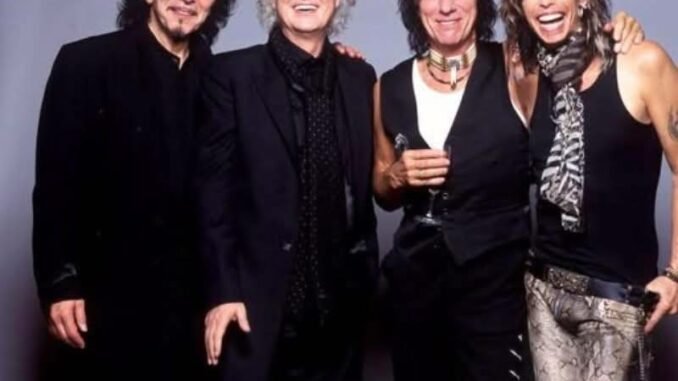
In 2007, a singular photograph immortalized a once-in-a-lifetime gathering of rock royalty: Tony Iommi, Jimmy Page, Jeff Beck, and Steven Tyler — four titans whose individual contributions helped define and reshape the very fabric of modern music. For fans and historians alike, it wasn’t just a snapshot; it was a convergence of eras, styles, and legacies that continue to echo through generations.
Tony Iommi: The Architect of Heavy Metal
Tony Iommi, the founding guitarist of Black Sabbath, stood in the photo as the godfather of heavy metal. With down-tuned guitars, doomy riffs, and a pioneering spirit, Iommi carved out a sound that was darker, heavier, and more ominous than anything before it. His resilience — having lost the tips of two fingers in a factory accident — became part of his mythos, as he innovated his playing technique to accommodate prosthetic fingertips. From “Iron Man” to “Children of the Grave,” Iommi’s music not only inspired legions of bands across metal subgenres but laid the groundwork for the genre itself. His presence in that photo was not just symbolic — it was foundational.
Jimmy Page: The Sorcerer of Hard Rock
Beside Iommi stood Jimmy Page, the enigmatic force behind Led Zeppelin. With his dragon-emblazoned outfits and violin bow solos, Page brought mysticism and cinematic flair to rock guitar playing. More than a player, Page was a composer and producer, meticulously crafting Zeppelin’s genre-spanning sound — from the bone-rattling riffs of “Whole Lotta Love” to the acoustic elegance of “Going to California.” His guitar work combined blues authenticity with psychedelic experimentation and eastern modalities, forever altering how rock could sound and feel. Page’s aura in that photo wasn’t just of a rock icon — he was a magician of tone, structure, and scale.
Jeff Beck: The Innovator’s Innovator
Jeff Beck, often described as the guitarist’s guitarist, embodied the experimental soul of British rock. Rising to fame with The Yardbirds before embarking on a prolific solo career, Beck refused to be confined to any one genre. His 1975 masterpiece Blow by Blow was a fusion of jazz, rock, funk, and blues — decades ahead of its time. With minimal reliance on pedals or effects, Beck used his fingers, whammy bar, and volume knob like extensions of his spirit. His tone could whisper, scream, or sing, and always with unmistakable precision. Beck’s presence in that 2007 photo was the quiet defiance of convention — the artist who walked his own path and inspired others to find theirs.
Steven Tyler: The Voice of Swagger and Survival
Unlike the other three guitar giants, Steven Tyler brought a different energy to the frame — that of a frontman, a showman, and a survivor. As the lead vocalist of Aerosmith, Tyler’s charisma, outrageous fashion, and unmistakable voice turned him into one of rock’s most electric figures. From the raw grit of “Dream On” to the swagger of “Walk This Way,” Tyler channeled blues, glam, and punk into an explosive package. His stage presence was magnetic, his voice a cocktail of grit and range. By 2007, Tyler had not only weathered decades of fame, addiction, and reinvention, but remained a vital force in rock’s mainstream and cultural dialogue.
A Moment of Crossroads and Legacy
The 2007 photograph was more than a celebrity hangout — it was a cultural artifact. Each figure represented a different face of rock’s revolution: Iommi’s seismic riffs, Page’s sonic sorcery, Beck’s virtuosic curiosity, and Tyler’s vocal fire. Though their paths rarely intersected musically, they shared common DNA: the blues roots, the improvisational spirit, and the fierce dedication to pushing music forward.
In that frozen moment, captured with candid warmth, the weight of rock history stood still. It wasn’t about ego or nostalgia. It was about a shared understanding — that each of them, in their own way, didn’t just play music. They transformed it.
Leave a Reply